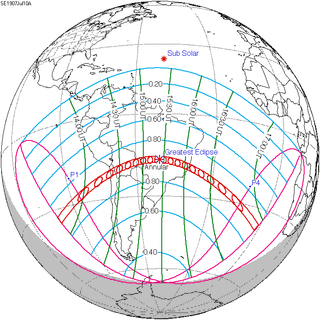| Solar eclipse of July 10, 1907 | |
|---|---|
| Type of eclipse | |
| Nature | Annular |
| Gamma | −0.6313 |
| Magnitude | 0.9456 |
| Maximum eclipse | |
| Duration | 443 s (7 min 23 s) |
| Coordinates | 16°54′S 50°54′W / 16.9°S 50.9°W |
| Max. width of band | 258 km (160 mi) |
| Times (UTC) | |
| Greatest eclipse | 15:24:32 |
| References | |
| Saros | 125 (48 of 73) |
| Catalog # (SE5000) | 9298 |
An annular solar eclipse occurred at the Moon's ascending node of orbit on Wednesday, July 10, 1907,[1][2][3][4] with a magnitude of 0.9456. A solar eclipse occurs when the Moon passes between Earth and the Sun, thereby totally or partly obscuring the image of the Sun for a viewer on Earth. An annular solar eclipse occurs when the Moon's apparent diameter is smaller than the Sun's, blocking most of the Sun's light and causing the Sun to look like an annulus (ring). An annular eclipse appears as a partial eclipse over a region of the Earth thousands of kilometres wide. Occurring only about 17 hours after apogee (on July 9, 1907, at 22:20 UTC), the Moon's apparent diameter was smaller.[5]
Annularity was visible from Chile, Bolivia (including its capital Sucre), and Brazil. A partial eclipse was visible for most of South America and parts of southern Central America.
- ^ "July 10, 1907 Annular Solar Eclipse". timeanddate. Retrieved 31 July 2024.
- ^ "Eclipse of the sun". The Daily Telegraph. London, Greater London, England. 1907-07-10. p. 4. Retrieved 2023-11-01 – via Newspapers.com.
- ^ "Eclipse of sun will occur today". The Washington Times. Washington, District of Columbia. 1907-07-10. p. 5. Retrieved 2023-11-01 – via Newspapers.com.
- ^ "Eclipse of the sun". Grimsby Evening Telegraph. Grimsby, Humberside, England. 1907-07-11. p. 2. Retrieved 2023-11-01 – via Newspapers.com.
- ^ "Moon Distances for London, United Kingdom, England". timeanddate. Retrieved 31 July 2024.
